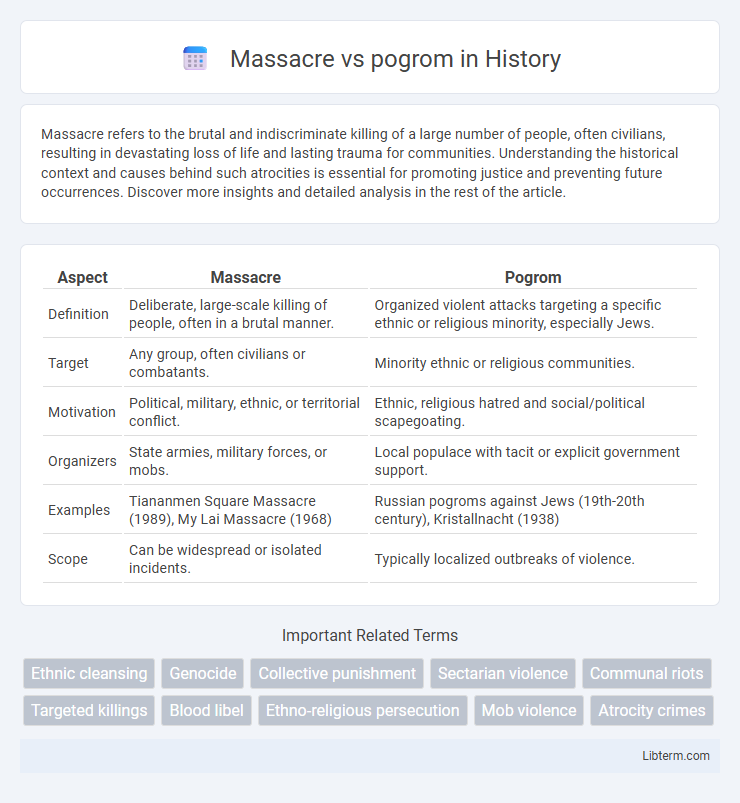Massacre refers to the brutal and indiscriminate killing of a large number of people, often civilians, resulting in devastating loss of life and lasting trauma for communities. Understanding the historical context and causes behind such atrocities is essential for promoting justice and preventing future occurrences. Discover more insights and detailed analysis in the rest of the article.
Table of Comparison
| Aspect | Massacre | Pogrom |
|---|---|---|
| Definition | Deliberate, large-scale killing of people, often in a brutal manner. | Organized violent attacks targeting a specific ethnic or religious minority, especially Jews. |
| Target | Any group, often civilians or combatants. | Minority ethnic or religious communities. |
| Motivation | Political, military, ethnic, or territorial conflict. | Ethnic, religious hatred and social/political scapegoating. |
| Organizers | State armies, military forces, or mobs. | Local populace with tacit or explicit government support. |
| Examples | Tiananmen Square Massacre (1989), My Lai Massacre (1968) | Russian pogroms against Jews (19th-20th century), Kristallnacht (1938) |
| Scope | Can be widespread or isolated incidents. | Typically localized outbreaks of violence. |
Defining Massacre and Pogrom
A massacre refers to a deliberate and brutal slaughter of a large number of people, often indiscriminate and carried out by military forces, mobs, or organized groups. A pogrom specifically denotes violent riots aimed at the massacre or persecution of an ethnic or religious group, primarily targeting Jewish communities in Eastern Europe. While massacres can occur in various contexts, pogroms are defined by their ethno-religious motivation and systematic nature.
Historical Origins of Massacres and Pogroms
Massacres trace their historical origins to large-scale violent events often linked to warfare or political repression, where indiscriminate killing of groups occurs regardless of ethnicity or religion. Pogroms specifically emerged in Eastern Europe during the late 19th and early 20th centuries as targeted violent attacks against Jewish communities, fueled by ethnic hatred and institutionalized antisemitism. Understanding the distinct origins highlights the massacre as a broader concept of mass violence, while pogroms represent ethnically motivated communal violence with deep socio-political roots in regions like Tsarist Russia.
Key Differences Between Massacre and Pogrom
Massacres involve the indiscriminate and large-scale killing of people, often during armed conflict, without specific ethnic or religious targeting. Pogroms specifically denote violent attacks aimed at particular ethnic or religious groups, especially Jews, characterized by both killing and widespread destruction of property. The key difference lies in pogroms being targeted, organized persecutions rooted in deep-seated prejudice, while massacres can be more indiscriminate acts of mass violence.
Common Motives Behind Massacres and Pogroms
Massacres and pogroms often stem from deep-seated ethnic, religious, or political tensions that incite collective violence against targeted groups. Common motives include scapegoating minorities during social or economic crises, political power struggles, and attempts to enforce ideological conformity. Historical examples reveal patterns of systemic discrimination and fear-driven aggression that underlie these violent outbreaks.
Notable Examples of Massacres
Notable examples of massacres include the Nanking Massacre, where hundreds of thousands of Chinese civilians were killed by Japanese troops during World War II, and the My Lai Massacre in Vietnam, where American soldiers killed hundreds of unarmed civilians in 1968. The Srebrenica massacre, part of the Bosnian War, resulted in the systematic killing of more than 8,000 Bosniak men and boys by Bosnian Serb forces. These incidents highlight large-scale, targeted killings of civilians or combatants, distinguishing massacres from pogroms, which typically involve organized attacks against specific ethnic or religious groups, often with a component of mob violence.
Notable Examples of Pogroms
Notable examples of pogroms include the 1903 Kishinev pogrom in the Russian Empire, where over 40 Jews were killed and hundreds injured, and the 1941 Lviv pogroms in Nazi-occupied Ukraine, resulting in thousands of Jewish deaths. Pogroms are characterized by violent riots aimed specifically at massacre and persecution of a particular ethnic or religious group, mostly Jewish communities in Eastern Europe. Unlike general massacres, pogroms often involve local populations participating in targeted violence encouraged or tolerated by authorities.
Impact on Targeted Communities
Massacres cause immediate, large-scale loss of life and widespread trauma, severely destabilizing targeted communities and often leading to displacement and long-term psychological scars. Pogroms involve organized, often state-sanctioned violence, combining physical destruction with economic devastation by targeting homes, businesses, and cultural institutions, which cripples community infrastructure and communal identity. Both forms of violence erode social cohesion, perpetuate fear, and hinder recovery, with pogroms frequently embedding systemic discrimination and exclusion into the affected populations' social fabric.
Legal and Moral Implications
Massacres involve indiscriminate killing of a large number of people, often without legal justification, resulting in severe breaches of international human rights laws and war crime statutes. Pogroms specifically target ethnic or religious groups, constituting acts of ethnic cleansing or genocide under international law, with profound moral implications related to systemic hate and discrimination. Both events prompt global condemnation, demanding accountability through legal prosecutions and ethical reparations to address victims' suffering.
Media Representation and Misuse of Terms
Media representation often blurs the distinction between massacre and pogrom, with massacres referring to large-scale, indiscriminate killings and pogroms specifically targeting ethnic or religious groups. This misuse leads to oversimplified narratives that can obscure underlying historical contexts and the systemic nature of pogroms. Precise terminology is critical in journalism to accurately inform public perception and avoid minimizing the targeted violence inherent in pogroms.
Preventing Massacres and Pogroms in Modern Society
Preventing massacres and pogroms in modern society requires robust legal frameworks that enforce anti-hate crime laws and protect minority rights. Effective community engagement and education programs promote tolerance and reduce ethnic or religious tensions that often trigger such violence. Early intervention by law enforcement and international cooperation in monitoring hate groups are critical to stopping these atrocities before they escalate.
Massacre Infographic

 libterm.com
libterm.com